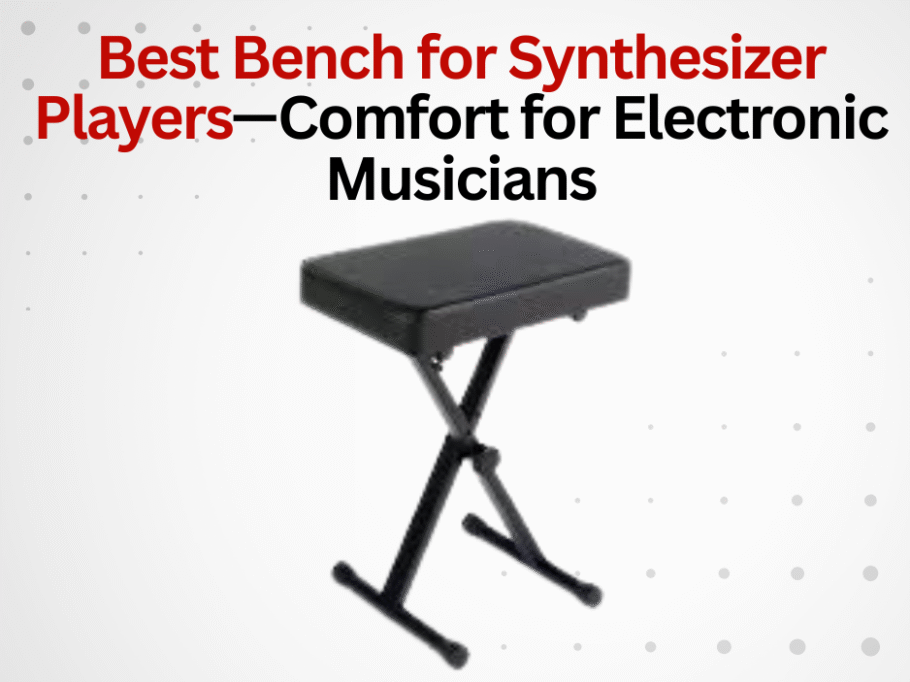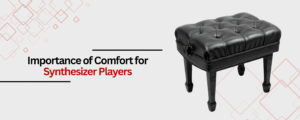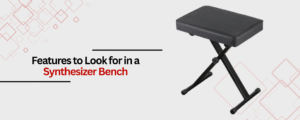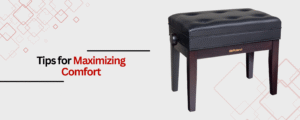For electronic musicians, comfort during long sessions is essential. The right piano bench can make a significant difference in performance, posture, and overall well-being. Synthesizer players, who often shift between multiple keyboards and controllers, require a bench that supports flexibility, durability, and ergonomic alignment. The features that define the best bench for synthesizer use will be explored, with a focus on how comfort can be maximized for electronic musicians.
The Importance of Comfort for Synthesizer Players
Extended periods at a synthesizer setup can lead to discomfort if seating is not properly designed. Fatigue, back pain, and poor posture are common issues when benches lack adequate support or adjustability. For electronic musicians, whose creative sessions may last for hours, a comfortable and supportive bench is not just a luxury—it is a necessity.
Ergonomics and Support:
Ergonomic design is frequently prioritized to promote healthy posture and reduce strain. Adjustable height options are considered crucial, as they allow the keyboard bench to be aligned with various synthesizer and keyboard heights. Padding should be thick and resilient, providing comfort without sagging over time. The width and stability of the bench are also important, especially for musicians who move laterally between multiple instruments.
Features to Look for in a Synthesizer Bench
Adjustable Height:
An adjustable bench is often preferred for synthesizer players. This feature enables musicians to tailor the seat height to their specific setup, ensuring wrists and arms remain in a neutral, relaxed position. Benches with smooth, silent adjustment mechanisms are valued for their convenience during live performances or recording sessions.
Quality Padding and Materials:
High-density foam or memory foam padding is recommended for long-term comfort. Upholstery made from durable, easy-to-clean materials such as vinyl or leatherette is often chosen to withstand frequent use. The best benches combine comfort with resilience, maintaining their shape and support over time.
Stability and Portability:
A stable base is essential to prevent wobbling, which can disrupt concentration and performance. Non-slip feet or rubberized end caps are commonly included for added security. For musicians who travel or perform at different venues, lightweight and foldable benches are considered advantageous, allowing for easy transport without sacrificing durability.
Storage and Space-Saving Design:
Some piano stools are designed with built-in storage compartments, providing a convenient place for cables, pedals, or sheet music. Space-saving designs, such as those with slim profiles or foldable legs, are particularly appreciated in home studios or compact performance spaces.
Recommended Benches for Electronic Musicians
Several models have been recognized for their comfort and suitability for synthesizer players. Piano Stools like the Roland RPB-300BK are frequently mentioned for their ergonomic features and durable construction. The Roland RPB-300BK is equipped with adjustable height and a padded seat, making it ideal for long sessions.
Other options, such as the On Stage KT7800+ and K&M benches, are also popular among electronic musicians. These benches are known for their robust frames, non-slip feet, and easy adjustability, ensuring consistent support during demanding performances.
Upgrade your practice and performance setup—choose a piano bench that delivers ergonomic comfort and reliable support.
Find the ideal piano bench for your space and playing style—explore adjustable, cushioned options built for lasting use.
Tips for Maximizing Comfort
Maintain Proper Posture:
It is recommended that musicians sit with feet flat on the floor and knees at a right angle. The bench height should be adjusted so that arms rest comfortably at keyboard level, reducing strain on shoulders and wrists.
Take Regular Breaks:
Frequent breaks are advised, especially during extended sessions. Standing, stretching, and moving around can help prevent fatigue and promote circulation.
Assess and Replace Padding:
Over time, padding may compress and lose its supportive qualities. It is beneficial to periodically check the condition of the seat and replace or add a cushion if necessary.
Conclusion
The best keyboard stool for synthesizer players is one that brings together ergonomic design, adjustability, and durable materials to ensure lasting comfort. By choosing a bench with features such as adjustable height, high-quality padding, and stable construction, electronic musicians can significantly enhance both their practice and performance experiences. Prioritizing comfort and support not only fosters creativity but also helps maintain long-term health and enjoyment at the synthesizer.
Brands like 5 Core, Donner, and Roland have become popular choices among electronic musicians for their commitment to comfort, adjustability, and reliability. Models from these brands are frequently selected for their ergonomic features, sturdy build, and space-saving designs, making them well-suited for both home studios and live performances. Investing in a bench from a trusted brand can make a noticeable difference in the daily life of any synthesizer player.




